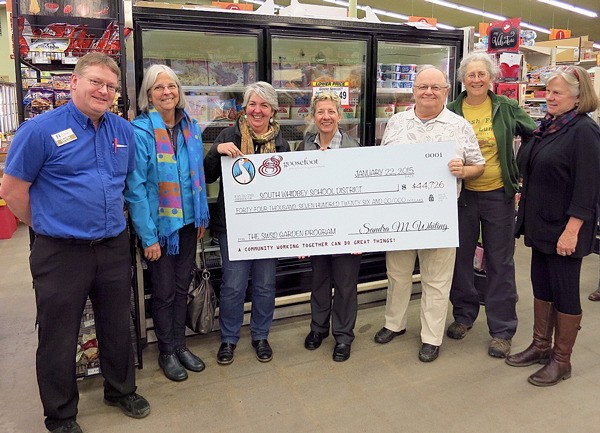The South Whidbey School District Garden Program received a check for $44,726 on Thursday afternoon.
The donations came from the community and the non-profit organization, Goosefoot. In October, Goosefoot offered to match all community donations to the school’s program up to $15,000. The challenge was met and surpassed, with donations from the community amounting to over $22,000.
The Goose Grocer, owned by Goosefoot, decided to match the entire amount, rather than the original $15,000. The donation will go directly to the school garden program for the 2014-15 school year.
According to a recent news release, the grocer is offering to repeat the $15,000 challenge grant for each of the following two school years, 2015-16 and 2016-17.
“The Goose is now in a position to give back and the school garden program appealed to us on many different levels,” said Sandra Whiting, Goosefoot executive director, according to the release. “Goosefoot is currently researching ways to support our local food system. Instilling an appreciation of fresh vegetables at an early age will have a ripple effect for years to come.”
The garden program is the result of a collaboration amongst Whidbey Island non-profit organizations Good Cheer Food Bank, Goosefoot, South Whidbey School District, Whidbey Institute and Whidbey Island Nourishes.
Students farm vegetables such as peas, carrots, broccoli and kale in the school farm located between South Whidbey Academy and South Whidbey Elementary and in a field at Langley Middle School.
Cary Peterson heads the effort as head farmer and is assisted by a handful of volunteers.
The Fresh Food on the Table program ensures that vegetables are served in lunch rooms district-wide, under the protocol of food management service Chartwells. The South Whidbey School District is the first in the nation to follow the Chartwells School Garden Guide to provide student-grown produce in school lunch on a regular basis.
More than receiving fresh produce in the lunch line, students are able to learn garden-based curriculum and gain insight into the ways in which food makes it from the farm to their plates.
Some of the harvested vegetables go to Whidbey Island Nourishes and the Good Cheer Food Bank, as well.



